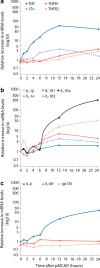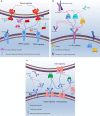Post-stroke inflammation-target or tool for therapy?
- PMID: 30483945
- PMCID: PMC6482288
- DOI: 10.1007/s00401-018-1930-z
Post-stroke inflammation-target or tool for therapy?
Abstract
Inflammation is currently considered a prime target for the development of new stroke therapies. In the acute phase of ischemic stroke, microglia are activated and then circulating immune cells invade the peri-infarct and infarct core. Resident and infiltrating cells together orchestrate the post-stroke inflammatory response, communicating with each other and the ischemic neurons, through soluble and membrane-bound signaling molecules, including cytokines. Inflammation can be both detrimental and beneficial at particular stages after a stroke. While it can contribute to expansion of the infarct, it is also responsible for infarct resolution, and influences remodeling and repair. Several pre-clinical and clinical proof-of-concept studies have suggested the effectiveness of pharmacological interventions that target inflammation post-stroke. Experimental evidence shows that targeting certain inflammatory cytokines, such as tumor necrosis factor, interleukin (IL)-1, IL-6, and IL-10, holds promise. However, as these cytokines possess non-redundant protective and immunoregulatory functions, their neutralization or augmentation carries a risk of unwanted side effects, and clinical translation is, therefore, challenging. This review summarizes the cell biology of the post-stroke inflammatory response and discusses pharmacological interventions targeting inflammation in the acute phase after a stroke that may be used alone or in combination with recanalization therapies. Development of next-generation immune therapies should ideally aim at selectively neutralizing pathogenic immune signaling, enhancing tissue preservation, promoting neurological recovery and leaving normal function intact.
Keywords: Cytokines; Drugs; Immune therapy; Ischemia; Neuroprotection.
Figures



Similar articles
-
IL-33 modulates inflammatory brain injury but exacerbates systemic immunosuppression following ischemic stroke.JCI Insight. 2018 Sep 20;3(18):e121560. doi: 10.1172/jci.insight.121560. eCollection 2018 Sep 20. JCI Insight. 2018. PMID: 30232272 Free PMC article.
-
Ginsenoside Rd Is Efficacious Against Acute Ischemic Stroke by Suppressing Microglial Proteasome-Mediated Inflammation.Mol Neurobiol. 2016 May;53(4):2529-40. doi: 10.1007/s12035-015-9261-8. Epub 2015 Jun 17. Mol Neurobiol. 2016. PMID: 26081140 Clinical Trial.
-
Augmented β2-adrenergic signaling dampens the neuroinflammatory response following ischemic stroke and increases stroke size.J Neuroinflammation. 2019 May 28;16(1):112. doi: 10.1186/s12974-019-1506-4. J Neuroinflammation. 2019. PMID: 31138227 Free PMC article.
-
Inflammatory cytokines in experimental and human stroke.J Cereb Blood Flow Metab. 2012 Sep;32(9):1677-98. doi: 10.1038/jcbfm.2012.88. Epub 2012 Jun 27. J Cereb Blood Flow Metab. 2012. PMID: 22739623 Free PMC article. Review.
-
Targeting vascular inflammation in ischemic stroke: Recent developments on novel immunomodulatory approaches.Eur J Pharmacol. 2018 Aug 15;833:531-544. doi: 10.1016/j.ejphar.2018.06.028. Epub 2018 Jun 20. Eur J Pharmacol. 2018. PMID: 29935175 Free PMC article. Review.
Cited by
-
PI3KC2β inactivation stabilizes VE-cadherin junctions and preserves vascular integrity.EMBO Rep. 2021 Jun 4;22(6):e51299. doi: 10.15252/embr.202051299. Epub 2021 Apr 20. EMBO Rep. 2021. PMID: 33880878 Free PMC article.
-
Genetic Modifiers at the Crossroads of Personalised Medicine for Haemoglobinopathies.J Clin Med. 2019 Nov 9;8(11):1927. doi: 10.3390/jcm8111927. J Clin Med. 2019. PMID: 31717530 Free PMC article.
-
Inflammatory Cytokines and Risk of Ischemic Stroke: A Mendelian Randomization Study.Front Pharmacol. 2022 Jan 17;12:779899. doi: 10.3389/fphar.2021.779899. eCollection 2021. Front Pharmacol. 2022. PMID: 35111052 Free PMC article.
-
Signaling pathways involved in ischemic stroke: molecular mechanisms and therapeutic interventions.Signal Transduct Target Ther. 2022 Jul 6;7(1):215. doi: 10.1038/s41392-022-01064-1. Signal Transduct Target Ther. 2022. PMID: 35794095 Free PMC article. Review.
-
Tumor Necrosis Factor (TNF)-α-Stimulated Gene 6 (TSG-6): A Promising Immunomodulatory Target in Acute Neurodegenerative Diseases.Int J Mol Sci. 2023 Jan 6;24(2):1162. doi: 10.3390/ijms24021162. Int J Mol Sci. 2023. PMID: 36674674 Free PMC article. Review.
References
-
- Ali C, Nicole O, Docagne F, Lesne S, MacKenzie ET, Nouvelot A, et al. Ischemia-induced interleukin-6 as a potential endogenous neuroprotective cytokine against NMDA receptor-mediated excitotoxicity in the brain. J Cereb Blood Flow Metab. 2000;20:956–966. doi: 10.1097/00004647-200006000-00008. - DOI - PubMed
Publication types
MeSH terms
Substances
Grants and funding
LinkOut - more resources
Full Text Sources
Medical

